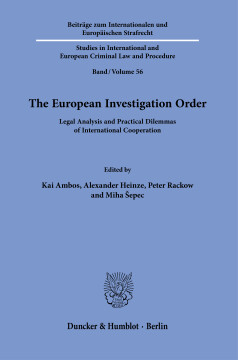The European Investigation Order

BOOK
Cite BOOK
Style
Format
The European Investigation Order
Legal Analysis and Practical Dilemmas of International Cooperation
Editors: Ambos, Kai | Heinze, Alexander | Rackow, Peter | Šepec, Miha
(2023)
Additional Information
Book Details
About The Author
Peter Rackow ist seit 2018 außerplanmäßiger Professor an der Juristischen Fakultät der Georg-August-Universität (Göttingen) und seit 2021 Geschäftsführer des Göttinger Vereins zur Förderung der Strafrechtswissenschaft und Kriminologie sowie ihrer praktischen Anwendung e.V. Nach seiner Habilitation (2007) lehrte er ab 2010 an der Deutschen Hochschule der Polizei (Münster-Hiltrup) und war ab 2013 als Anwalt tätig, insbesondere im Bereich des Verkehrsrechts. Er ist langjähriges Mitglied des Landsjustizprüfungsamts Celle. Seine Forschungstätigkeit bezieht sich insbesondere auf den Bereich der Straftaten gegen die öffentliche Ordnung.Miha Šepec, associate professor of criminal law, graduated in 2010 at the Faculty of Law of University of Ljubljana and later in 2015 finished his PhD in criminal law field at Faculty of Law of University of Maribor. He has published more than 150 works in the field of criminal law, international and constitutional law. His specialization is cybercrime, criminal law theory, criminal process, media law, and criminal constitutional doctrine. He is the single author of a scientific monography Cybercrime: Criminal Offences and Criminal Law Analysis, editor and leading author of the Commentary of the Slovenian Criminal Code and one of the authors of the Commentary of the Slovenian Constitution.Abstract
This book is the last and final part of the project ›European Investigation Order - legal analysis and practical dilemmas of international cooperation - EIO-LAPD‹ in the EU Justice Programme. It presents a contribution to the European-wide discourse on how to enhance the effectiveness and the practical implementation of the Directive 2014/41/EU on the European Investigation Order in Criminal Matters of the European Parliament and of the Council of 3 April 2014 (EIO). Through national reports (Part I), the analysis of selected topics (Part II), and shorter case comments (Part III), the book’s objective is to equip target groups with specialised knowledge about the cross-border evidence gathering procedure described in the Directive 2014/41/EU. Unlike other parts of the project, this monograph is targeted at the legal community, students of law, NGOs and the interested public. Its goal is to achieve a greater inclusion of dilemmas connected with the practical application of the Directive into the legal and public discourse.This book is the last and final part of the project ›European Investigation Order - legal analysis and practical dilemmas of international cooperation - EIO-LAPD‹ in the EU Justice Programme. It presents a contribution to the European-wide discourse on how to enhance the effectiveness and the practical implementation of the Directive 2014/41/EU on the European Investigation Order in Criminal Matters of the European Parliament and of the Council of 3 April 2014 (EIO). Through national reports (Part I), the analysis of selected topics (Part II), and shorter case comments (Part III), the book’s objective is to equip target groups with specialised knowledge about the cross-border evidence gathering procedure described in the Directive 2014/41/EU. Unlike other parts of the project, this monograph is targeted at the legal community, students of law, NGOs and the interested public. Its goal is to achieve a greater inclusion of dilemmas connected with the practical application of the Directive into the legal and public discourse.
